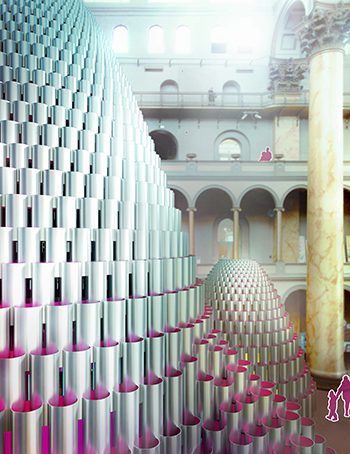Summer VISUAL arts preview
By • May 24, 2017 0 551

At some point soon, we will all need respite from the summer heat — some dimly lit, air-conditioned place away from the blistering July sun, where we can pursue our curiosities and let sweat-soaked shirts dry cool against our backs. And when you’re inevitably walking your out-of-town guests around the Mall and the dirt kicks up like coal smoke around your throbbing ankles and the sun is turning the back of your neck into a medium rare sirloin, a museum is a most relieving sanctuary. Here are the museum exhibitions opening this summer that we are most looking forward to seeing.
Antebellum Portraits by Matthew Brady
National Portrait Gallery, opens June 16
Mathew Brady (1822–1896) may be best known today for his Civil War–era photographs, but he established his reputation more than a decade before the war. Brady opened his first daguerreotype portrait studio in New York City in 1844, just five years after the introduction of the first commercially practical form of photography. By 1851, he was among the most successful camera artists in the United States and claimed top honors for his daguerreotypes at the Crystal Palace exhibition in London. When a new photographic medium — the ambrotype — began to eclipse the daguerreotype in the mid-1850s, Brady adapted, creating some of the most beautiful ambrotype portraits ever produced.
As the decade drew to a close, Brady’s studio remained in the vanguard of photographic innovation, producing handsome, salted-paper print portraits from glass negatives. This Daguerreian Gallery exhibition will trace the trajectory of Brady’s early career through portrait daguerreotypes, ambrotypes and salted-paper prints in the National Portrait Gallery’s collection. Contemporary engravings, as well as several advertising broadsides Brady used to market his portrait enterprise, will also be included.
Summer of Yoko Ono
Hirshhorn Museum, June 17 to Sept. 17
In celebration of the 10th anniversary of Yoko Ono’s “Wish Tree for Washington, DC,” the Hirshhorn will present a selection of the artist’s most emotionally charged installations and performances. Over the past decade, nearly 80,000 handwritten wishes tied by visitors onto “Wish Tree,” a gift from the artist in 2007, have been collected and sent to Ono’s “Imagine Peace Tower,” an outdoor artwork in Iceland that memorializes John Lennon.
Spanning the length of the museum’s lobby, the 40-foot-long installation “My Mommy Is Beautiful” invites visitors to bring a photograph or write a thought or memory about their mothers and attach it to the canvased wall.
Finally, Ono’s “Sky TV for Washington, DC” of 1966, a 24-hour live feed of the sky outside, will be reinstalled on the Hirshhorn’s third level. Conceived when Ono lived in a windowless apartment and dreamed of having the sky inside, “Sky TV” was one of the first works of art to harness the instant feedback capability of video, acting as a timely commentary on technology’s replacement of nature.
Parallax Gap
Renwick Gallery, opens July 1
“Parallax Gap” transforms the Renwick Gallery’s Bettie Rubenstein Grand Salon into a visual puzzle. This immersive, site-specific installation, designed by Los Angeles architecture firm Freeland Buck, explores examples of interplay between craft and architecture through a ceiling-suspended structure running the length of the Renwick’s iconic gallery. The installation embraces both Eastern and Western concepts of perspective through trompe l’oeil effects and multiple vanishing points, creating a sense of soaring architectural volume.
Drawings of ceilings of nine different iconic American buildings — including Union Terminal in Cincinnati and Newport’s Chateau-sur-Mer mansion — are fabricated using a collection of skewed vantage points. Laid near or atop one another, they create layers of both recognizable and abstracted architectural space that change as viewers move underneath. These perspectival illusions operate through the concept of parallax, or how the distance or depth of objects appears to vary when viewed from different lines of sight.
Hive
National Building Museum, July 4 to Sept. 4
Soaring 60 feet high to the uppermost reaches of the National Building Museum’s staggering Great Hall, “Hive” is an interactive architectural installation built entirely out of wound paper tubes. Varying in size from several inches to 10 feet high, the more than 2,700 tubes — all with a reflective silver exterior and a vivid magenta interior — will be interlocked to create three interconnected domed chambers.
Designed by Chicago-based Studio Gang, “Hive” recalls other built and natural structures: Saarinen’s Gateway Arch in St. Louis, Brunelleschi’s dome in Florence, vernacular Musgum mud huts in Cameroon, even the curvature of a spider’s web. By utilizing this catenary shape, each chamber will balance structural forces and support its own weight, while attaining a height that enables a unique acoustic signature.
The installation’s smaller chambers will feature tubular instruments ranging from simple drum-like tubes to chimes suspended within the space. The large main chamber is topped by a soaring dome that filters the natural light of the Great Hall and creates intricate light-and-shadow patterns.
Matthias MansEn: Configurations
National Gallery of Art, July 23 to Dec. 13
Matthias Mansen (b. 1958) is a contemporary Berlin-based artist whose work advances the long tradition of woodblock printing. Mansen masterfully layers printings from multiple blocks, sometimes employing “ghost prints” to achieve delicate modulations of tonal intensity and texture. Concerned with process nearly as much as final product, he works on numerous prints simultaneously and progressively carves and recarves his blocks. His projects are best exhibited in an ensemble, allowing the grammar and rhythms of his repeated cognate arrangements and consonant forms to become tangible.
Punctured Landscape
Art Museum of the Americas, through July 30
Marking the 150th anniversary of Canadian Confederation, “Punctured Landscape” explores Canada’s role as a country working toward a decolonized society, valuing the lives of Indigenous peoples, migrants and asylum seekers. The 17 contemporary artworks, and the moments in collective living memory they represent, are to be understood as “punctures,” asking the viewer to (re)consider his or her interpretation of Canada’s history, legacy and future.


